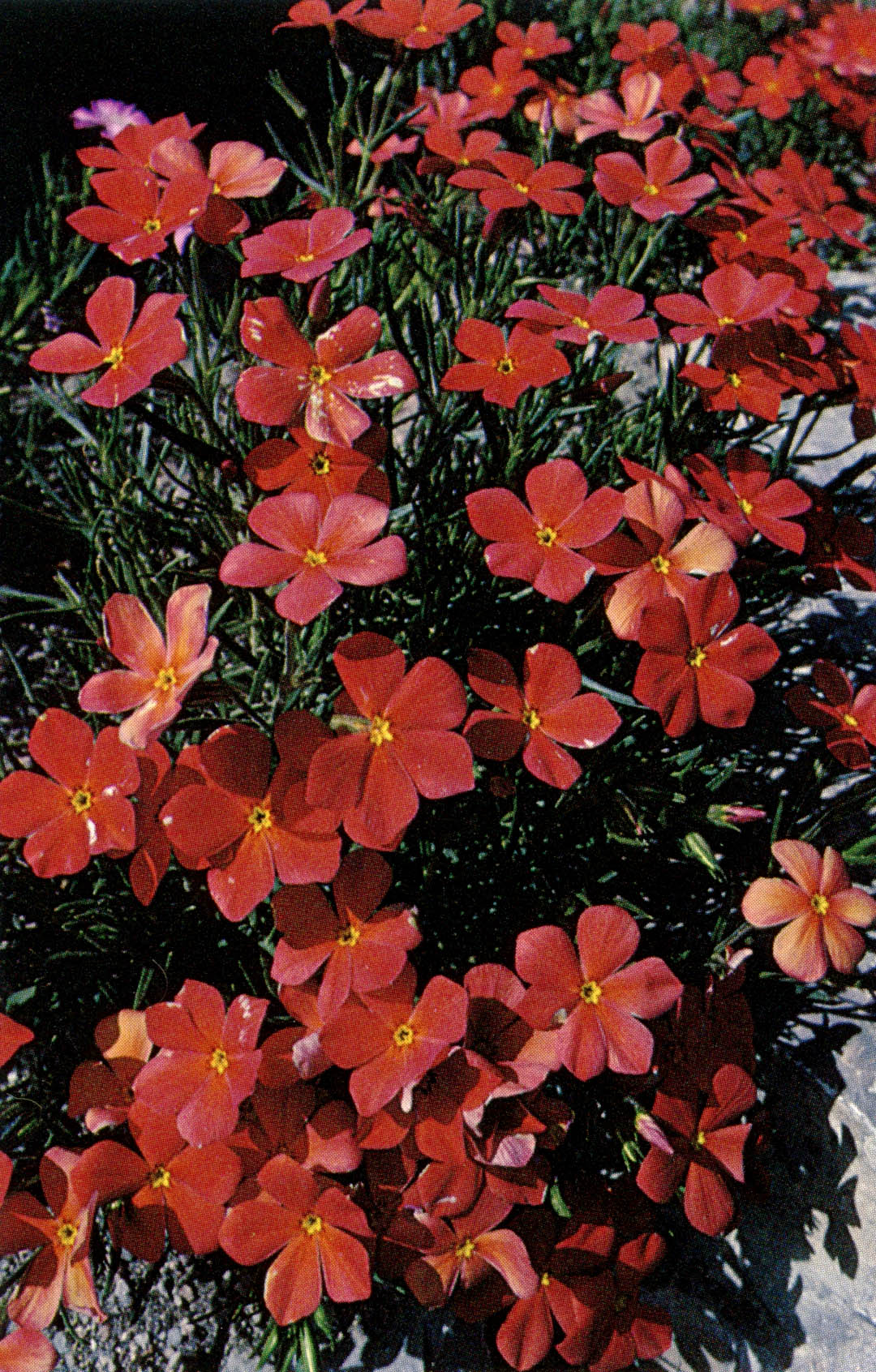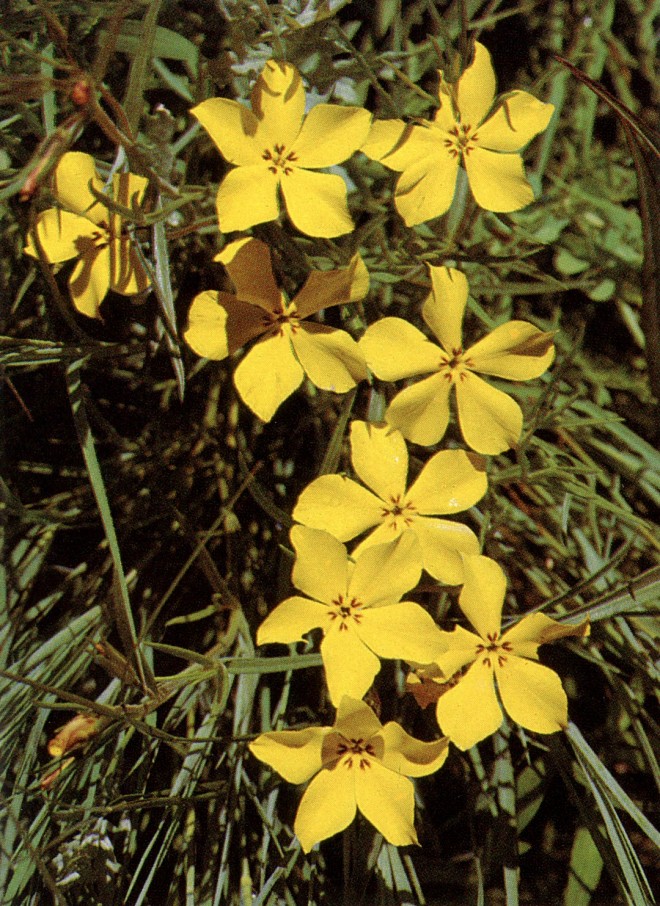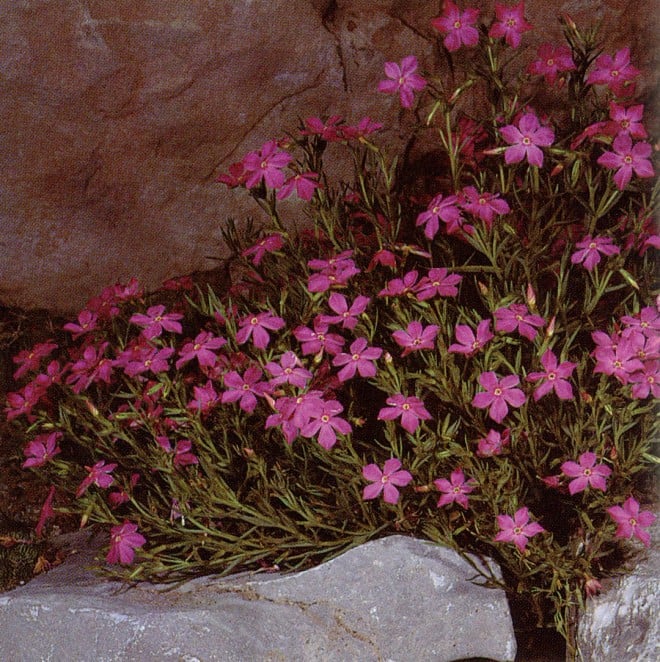

Contributor
- Topics: Archive, Plants You Need
[This] race [of phloxes], incomparably the most important that America has yet evolved for the benefit of the rock garden, and one of which it has an almost undisputed monopoly.
Reginald Farrer, The English Rock Garden, 1919.
No group of American plants has contributed more to gardens than phloxes — not only the tall border phloxes, but the mat-forming kinds that are such a boon to rock gardens in the spring. In The English Rock Garden, Reginald Farrer regretted the “long list of exquisite and longed-for alpines that are still vainly offering themselves to us on the desert mountains of America.” He was referring to the endless variety of cushion- and mat-forming phloxes that carpet the high plateaus and tundras of the American West. Little did Farrer suspect that among them was a group of plants that would give rise to ever-blooming perennials of great hardiness and, breaking away from the prevalent lavenders, pinks, and whites, would embrace the fiery end of the spectrum in their flowers.

The existence of a phlox with yellow flowers belonging to Phlox mesoleuca has been known to a few since 1887, when Cyrus Pringle found colonies of them some forty miles west of the city of Chihuahua in northern Mexico. He pressed and sold specimens of these phloxes to European herbaria, but, although rumors abounded, little was known of them among gardeners.
Paul Maslin examined specimens of these phloxes in the herbarium at the Royal Botanic Gardens at Kew on a trip to Britain in 1978. He wondered whether the faint yellow tint in the dried petals was attributable to age or whether, indeed, it represented a yellow-flowered phlox. Paul had spent many decades traveling throughout Mexico on expeditions to study reptiles, his professional specialty. After retirement, he devoted his energies to gardening and to the study of plants in the wild. In September 1978 he and his wife, Mary, launched an expedition into the Chihuahuan highlands to find the yellow phlox.
Their destination lay 1,500 miles from their home in Boulder, Colorado, in an inhospitable region still notorious for its banditos. Moreover, autumn is the rainy season in the Chihuahuan desert, and this was a particularly rainy year. Many of the bridges were washed out, requiring tedious and sometimes dangerous detours. Nevertheless, the Maslins persisted for ten days in the rugged Sierra Madre, searching for Pringle’s mysterious phlox.
The Chihuahuan mountains are a southerly extension of the Rockies. Much of the country west of Ciudad Chihuahua is similar to the foothills of the Rocky Mountains in Colorado so familiar to the Maslins. There are the same open, park-like forests of pine and oak, but the most striking similarity lies in the feeling of desolation characteristic of much of the countryside — the results of overgrazing. The effects of this practice on the wildlife of Mexico and the western United States cannot be overstated. It is obvious from accounts of visits to Chihuahua by Pringle and others in the nineteenth century that this once was a spectacularly floriferous region, yet the Maslins found only a few remnants of the original highland flora along roadsides and among bean fields on pieces of land unsuitable for cultivation and inconvenient for grazing cattle and horses.

One such strip of land lies between endless fields of corn and beans a few miles west of the city of Cuauhtémoc on the highlands of Chihuahua. After ten fruitless days in search of phlox throughout the province, the Maslins pulled off the road in order to take some medicine and Mary stepped out of the van onto the largest colony of scarlet phlox they had seen so far. Appropriately, an especially brilliant red-flowered plant selected from this colony has entered cultivation bearing her name, Phlox mesoleuca ‘Mary Maslin’. The extent of the patch she found is less than fifty feet in all directions, with only a few scattered individuals further west and none towards the city of Cuauhtémoc. The ground is deeply rutted with the tracks of horse-drawn buggies driven by Mennonites forbidden to ride on the highway. (Certain enterprising individuals in this sect have discovered that while most motorized vehicles may be ungodly, heavenly caveat does not extend to tractors, and now tractors can often be seen pulling horseless buggies to town.)
Among the numerous scarlet phloxes in this colony the Maslins also found some that were orange and a single, fading blossom that appeared to be yellow. Having already overstayed their allotted time in Chihuahua, they returned to Colorado, puzzled by the lack of seed in this colony and intrigued by the single yellow blossom. Paul resolved to return to Mexico to collect seed and to look for more yellow phloxes.
l accompanied Paul on the second expedition, which took place in November, immediately following severe flooding. Most of the bridges leading to Ciudad Chihuahua were washed out, and traffic had been halted for days, but, as if by magic, the roads were repaired as we arrived, and we progressed swiftly to the site of the scarlet phlox. Only a few flowers were left and the capsules were every bit as empty as they had been the previous month. The prospects of finding other colonies were not promising, but we proceeded southward toward the village of Cusihuiriachic, where Pringle had paused during his expedition. Here in a remnant of unplowed prairie surrounding a pond the thick grasses were filled with a rich variety of wildflowers, including the huge stars of Ipheion uniflorum (Milla uniflora) and seven species of Tradescantia and Commelina. The most common plant throughout the several-acre tract, however, was the yellow-flowered Chihuahuan phlox. Of the tens of thousands of individual stems in this colony, only a few dozen had flowers this late in the season. These revealed a tremendous range of petal shape and eye color, but the majority of flowers were a clear lemon yellow. After several hours of searching, we were able to gather a small number of seeds and collected specimens for cultivation and pressing.

Paul was to return to Chihuahua twice more in the next few years. The first of these visits took him to a point, some ten miles west of Cuauhtémoc, where he found the large colony of cerise-pink phlox from which the cultivar ‘Arroyo’ was selected. In 1981 Paul made his last trip to Chihuahua with Baldassare Mineo of Siskiyou Rare Plant Nursery and myself. On this occasion we found one more colony of the phlox with cerise flowers, some forty miles north of Cuauhtémoc. In this colony some plants had pure white flowers with deep violet markings in the eye — another variation in color for these Chihuahuan phloxes. There was also a small group of plants with deep crimson flowers rather darker than those of the group to the south from which ‘Mary Maslin’ had been selected.
In the next ten days we traveled throughout the Sierra Madre Occidental, as far as Durango, hundreds of miles to the south. In the course of the entire journey we were to find only one more colony of yellow-flowered phloxes, one more small colony with purple flowers, and no more of the brilliant red and orange phloxes. I have no doubt that these Chihuahuan phloxes were once common plants in the western highlands of Mexico. Now, overgrazing and cultivation have made them rare in nature. Even the few we found could be lost in a moment from the passage of vehicles or the work of zealous ploughmen.
Fortunately, it appears that they are quite easy in cultivation. For four years now a selection of these phloxes has flourished at Denver Botanic Gardens and at Siskiyou Rare Plant Nursery in Medford, Oregon, which offers them in a wider range of colors each year. In nature these are plants of loamy prairie and open woodland where soil is well-drained and rich. In the garden they seem to respond to sun, deep soil, good drainage, and regular watering.
The hardiness of these phloxes has been questioned because of their southerly origin. Perhaps they will prove tender in the coldest of climates, but one should remember that a number of Chihuahuan desert plants, such as Penstemon pinifolius and Heuchera sanguinea, have proven hardy far north of their range. Like these two plants, the phloxes represent southerly outliers of a genus found mainly in the north. It is obvious that they possess good hardiness, for the Chihuahuan phloxes have withstood long winters with repeated sub-zero temperatures at Denver Botanic Gardens with no protection at all.
Aside from their dazzling colors, the most remarkable feature of these plants is a long blooming period. In nature they flower from the start of autumn rains in August or early September to the time of heavy frosts in November. They remain dormant throughout much of the year, for spring in Chihuahua is the season when much of the countryside is dry.
In gardens these phloxes begin to bloom in early summer, often as early as May. They continue to send out flowers throughout the summer months (provided they are properly watered), reaching a peak in August and September when they present a dazzling mass of color. Most years they will persist in heavy bloom long past the first frosts. In Denver, as many as a hundred flowers have opened simultaneously in late November, when frost had occurred nightly for weeks.
The fiery phloxes of Chihuahua, a stunning addition to gardens in much of the western United States, in England, and parts of the Midwest, will remain a festive and lasting memorial to T. Paul Maslin.
Share:
Social Media
Garden Futurist Podcast
Most Popular
Videos
Topics
Related Posts

Low Maintenance Gardens – Better for Pollinators and People
Autumn 2022 “I come out every day. It’s therapy, my meditation.” Janet’s young garden transformed from overgrown, invasive plants to mostly natives. The dailiness of

Calochortophilia: A Californian’s Love Affair with a Genus
Summer 2022 I can chart the progression of my life by Calochortus. For the last two decades, at least. As a teenage girl growing up

Pacific Plant People: Carol Bornstein
Spring 2022 Public gardens play a key role in demonstrating naturalistic planting design, selecting native and adapted plants for habitat, and testing techniques for reducing

Add Year-Round Interest and Winter Blooms for Pollinators
Spring 2022 This article was created from an Interview by Merrill Jensen with Neil Bell in the Summer of 2021 for our Pacific Plant People









Responses